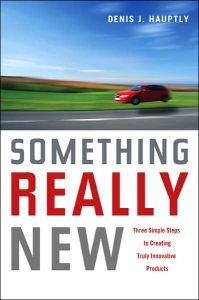Join getAbstract to access the summary!

Join getAbstract to access the summary!
Denis J. Hauptly
Something Really New
Three Simple Steps to Creating Truly Innovative Products
AMACOM, 2007
What's inside?
Some people, and companies, are just born creative. But, if you’re not a natural, you can learn it.
Recommendation
Too many books on innovation get bogged down in theory or assume that coming up with new ideas is both the point of innovation and its most important step. In contrast, Denis J. Hauptly cuts through the nonsense with a focus on the customer. Originality, in and of itself, isn’t enough, Hauptly says. He encourages innovation that results in useful, beautiful, interesting and profitable products, providing ideas and procedures you can use right away. He also provides “innovation workouts” that ask you to come up with products that solve common problems, and a list of readings. His book could be better organized, but getAbstract recommends it to product developers, for whom it will provide useful tools, and marketers, who must deal with a culture intoxicated by the next big thing.
Summary
About the Author
Denis J. Hauptly is vice president for technology strategy with a Swiss-based company and has held product-development positions with several companies.
















Comment on this summary